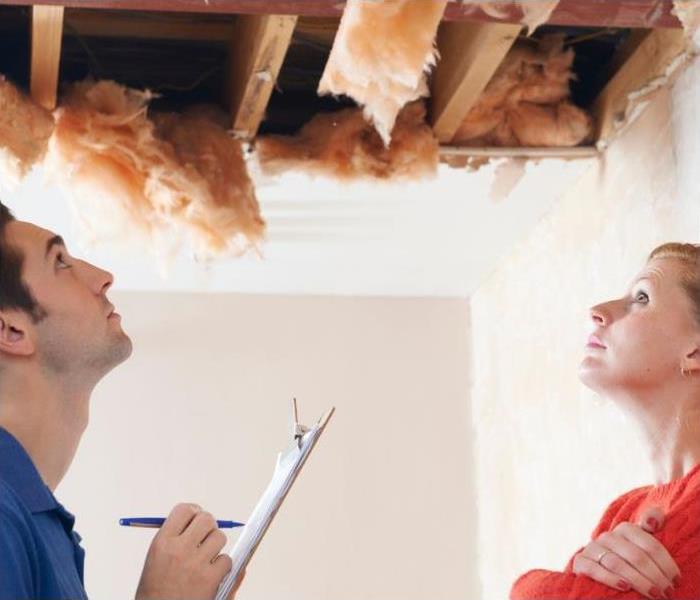Water Damage Inspection: How to Check Your Home After Heavy Rain
10/15/2024 (Permalink)
After heavy rainfall, doing a thorough water damage inspection is essential to protecting your home from long-term problems. If left untreated, water damage can lead to mold growth, structural issues, and costly repairs. Inspecting key areas of your home after rain will help you catch and tackle any issues early. If you're already seeing signs of water damage, check out water damage restoration Weymouth services or contact your local expert for professional help. Here's what to look for and how to prevent further damage.
Areas to Inspect for Water Damage
During your home inspection after rain, focus on these areas that are most vulnerable to water damage after heavy rain:
Roof
Start by carefully inspecting your roof for roof leaks. Look for damaged or missing shingles, as these can allow rainwater to seep through. Don't forget to check the attic for any signs of water seepage, such as damp insulation or dark spots on the wood. These signs may reveal underlying issues that need immediate attention.
Gutters and Downspouts
It is important to maintain a gutter properly to avoid water pooling near your home’s foundation. Clear out any debris, such as leaves and twigs, to ensure that gutters can channel water effectively. Make sure downspouts are directing water away from the house, ideally at least 3 to 6 feet away from the foundation. This helps prevent water from accumulating near your home and causing damage.
Foundation
Heavy rains can create foundation cracks or lead to water pooling around the base of your home. Inspect the foundation for any visible cracks or signs of water intrusion. If you notice water pooling, it can compromise the stability of your home and lead to serious structural issues if not tackled promptly.
Exterior Walls
Examine your exterior walls for any cracks or gaps where water may have entered. Look for damp patches or water stains around windows and doors, as these are key signs of rainwater intrusion. Even small openings can allow moisture to penetrate, leading to bigger problems like mold growth and rot.
Windows and Doors
Inspect the seals around your windows and doors for signs of wear or deterioration. Check for gaps or cracks in the caulking or weather stripping. Faulty window and door seals can allow water to leak into your home, resulting in potential water damage and increased energy costs.
Interior Walls and Ceilings
Once inside your home, check for stained walls and ceilings that may indicate leaks coming from the roof or exterior walls. Pay special attention to corners and areas near plumbing fixtures. Water stains can be a clear indicator of existing water damage and may require immediate repair to prevent further issues.
Floors
Finally, examine your floors for any signs of warping or dampness, particularly in areas like the basement, where basement flooding is common after heavy rain. Look for damp spots or discoloration that may indicate water pooling underneath the flooring. Taking the time to inspect these areas can help you identify and handle water damage before it escalates.
Tools to Use During Inspection
Certain tools can help you detect hidden water damage during your inspection:
- Moisture meter: Detects dampness behind walls and under floors.
- Infrared camera: Helps spot leaks by showing temperature differences caused by moisture.
- Flashlight: Useful for inspecting dark areas, like attics or crawl spaces.
Common Signs of Water Damage
During your water damage inspection, look out for these common signs:
- Mold and Mildew: These grow in damp areas and are clear indicators of a moisture problem. Check for visible mold growth in corners, on walls, and around windows. If you notice black, green, or white spots, tackle the moisture source immediately, as mold can lead to health issues and structural damage if left untreated.
- Musty Smell: A lingering musty smell often points to hidden water damage. This smell typically comes from damp or decaying materials. If you notice a musty smell in your home, investigate potential sources, such as water-stained areas, hidden leaks, or damp basements. Ignoring this smell may lead to more significant issues, including mold growth.
- Water Stains: Look for water stains on walls, ceilings, or floors. Discoloration, such as yellow, brown, or gray spots, is a major red flag for rainwater damage. These stains often indicate past or present leaks from roofs, plumbing, or exterior walls. Investigate the source of these stains to prevent further damage and ensure a safe living environment.
What to Do if You Find Water Damage
If you find water damage, take these steps immediately:
- Dry out the area: Use fans and dehumidifiers to dry wet areas quickly to avoid further damage and mold growth.
- Call a professional: For proper restoration, contact experts in water damage restoration to inspect and repair the damage.
Prevention Tips for Future Water Damage
Learn more about how to prevent water damage in your home. To prevent water damage after future rainstorms, follow these maintenance tips:
- Clean your gutters regularly: Gutter maintenance is very important. Make sure they can handle heavy rainfall.
- Inspect your roof: Do this annually for damaged shingles.
- Maintain Your Drainage System: Pay special attention to the area around your home’s foundation to keep water from pooling.
- Check window and door seals: Do this regularly for any wear and tear.
Protect Your Home: Get a Professional Water Damage Inspection
If you've noticed any signs of water damage after a heavy rain, don't delay. SERVPRO of Weymouth, Hingham, and Quincy offers expert water damage inspection and restoration services. Our team is ready 24/7 to help restore your home. Call us today at (781) 337-0344 or complete an online form to schedule your inspection and protect your home from further damage. SERVPRO® water damage services are here to help you keep your home safe and dry!






 24/7 Emergency Service
24/7 Emergency Service
